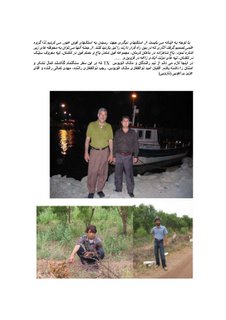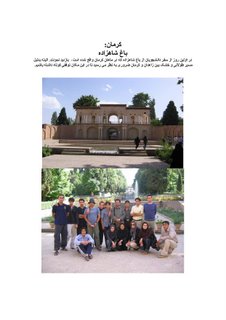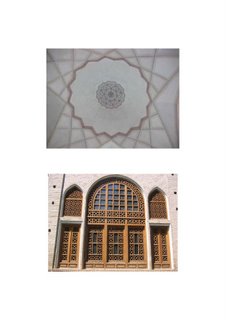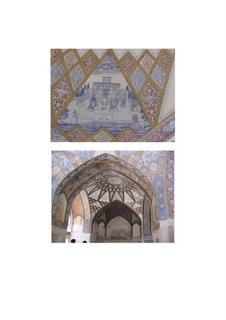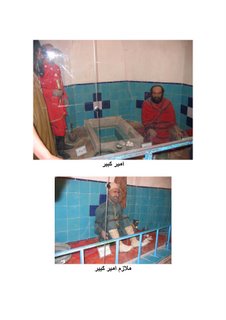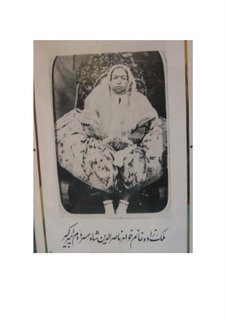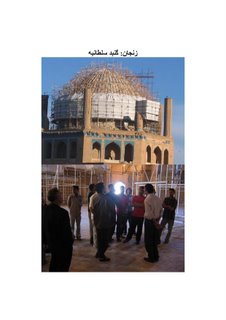Sunday, January 10, 2010
JOURNAL OF ARCHAEOLOGICAL STUDIES
Wednesday, October 01, 2008
What's brownish-purple, goes to the beach and stinks of rotting flesh?


New York's celebrity-obsessed Hamptons summer season got even sillier this week when a strange-looking, very dead creature washed up on a beach in Montauk at the far eastern end of New York's Long Island.
On Tuesday afternoon, a photo was posted on Gawker, the Big Apple's reigning gossip blog, which treated the Montauk monster with characteristic respect: "Good Luck With Your Hell Demons."
The animal looks like a bloated, hairless dog, except that it's got an eagle-like beak, a prominent brow ridge and a curiously elongated front paw.
This picture shows similarties between this monster and statue discovered at Persepolise.
Friday, September 12, 2008
http://www.tehrantimes.com/index_View.asp?code=170239
5000-year-old site discovered in southeastern Iran
Tehran Times Culture Desk TEHRAN --
Tehran Times Culture Desk TEHRAN --
A broad site dating back to the third millennium BC was discovered during the latest excavations in Bampur region in Sistan-Baluchestan Province, southeastern Iran.
“In the Bampur valley, there is an ancient site covered with sand mounds, which is as large as the Burnt City and may belong to a civilization as great as the civilization of that the city,” Mehdi Mortazavi, an archaeologist of the University of Sistan-Baluchestan, told the Persian service of CHN on Saturday. According to Mortazavi, the site measures 1x1.5 kilometer. “I feel sure that there are a large number of sites like this here. Such sites may even exist in nearby regions like Saravan,” he stated. Mortazavi refused to give more details about the location of the site for security reasons. “It’s better for the site to remain covered for the time being, because it will be plundered by illegal excavations if the precise location of the site is revealed,” he argued. Twenty sites -- mostly prehistoric -- have been discovered by the archaeologists of the University of Sistan-Baluchestan over the past few years. Covering an area of 152 hectares, the Burnt City, located 57 kilometers from the city of Zabol in Sistan-Baluchestan Province, is the largest prehistoric site of the province. It was one of the world’s largest conurbations at the dawn of the urban era and was well developed during the third millennium BC. It thus constitutes one of the country’s most important prehistoric sites. The city, which was burnt down three times, shows evidence of four stages of civilization. Since it was not rebuilt after the last conflagration, it has been named the Burnt City
“In the Bampur valley, there is an ancient site covered with sand mounds, which is as large as the Burnt City and may belong to a civilization as great as the civilization of that the city,” Mehdi Mortazavi, an archaeologist of the University of Sistan-Baluchestan, told the Persian service of CHN on Saturday. According to Mortazavi, the site measures 1x1.5 kilometer. “I feel sure that there are a large number of sites like this here. Such sites may even exist in nearby regions like Saravan,” he stated. Mortazavi refused to give more details about the location of the site for security reasons. “It’s better for the site to remain covered for the time being, because it will be plundered by illegal excavations if the precise location of the site is revealed,” he argued. Twenty sites -- mostly prehistoric -- have been discovered by the archaeologists of the University of Sistan-Baluchestan over the past few years. Covering an area of 152 hectares, the Burnt City, located 57 kilometers from the city of Zabol in Sistan-Baluchestan Province, is the largest prehistoric site of the province. It was one of the world’s largest conurbations at the dawn of the urban era and was well developed during the third millennium BC. It thus constitutes one of the country’s most important prehistoric sites. The city, which was burnt down three times, shows evidence of four stages of civilization. Since it was not rebuilt after the last conflagration, it has been named the Burnt City
Some recent open access journal material
Charles Ellwood Jones is working towards what he believes will be a fairly lengthy list of open access journals for Ancient Studies, likely to apear in the AWOL series. In the meantime, here are some open access runs of journals which have recently survaced.
Charles Ellwood Jones is the Librarian at the Institute for the Study of the Ancient World at NYU. From July 2005 to February 2008 he was the Head Librarian at the Blegen Library of the American School of Classical Studies at Athens. Before moving to Athens he spent twenty-two years as the Librarian at the Oriental Institute, The University of Chicago.
with especial thanks to him.
Annales du Service des antiquités de l'Egypte [Most of the early volumes of this periodical are available at the Internet Archive]
Archivo Español de Arqueología [The open access component of Archivo Español de Arqueología begins with volume 79 (2006)]
Bulletin of the Society for Arabian Studies [Volume 11 (2006) and following are available online]
Digital Medievalist [2005 - present]
Epigraphica Anatolica: Zeitschrift für Epigraphik und historische Geographie Anatoliens [Volumes 36 (2003) - 38 (2005) are online]
Gladius [The open access component of Gladius begins with volume 19 (1999)]
HistoriaeHuelva arqueológica [1975 - present]
Memorias de historia antigua [1977 - present]
Meroitic Newsletter - A Digital Compilation [Version 1.0 (Issues 1-21,23,24,27,28)]
Oracula - Revista Eletrônica de Pesquisas em Apocalíptica Judaica e Cristã [2005 - present]
Orientalistische Literaturzeitung [Early volumes (ca. 1-25) are available in open access format at the Internet Archive][1977 - present]
Quaternaire: Revue de l'Association française pour l'étude du Quaternaire [Volumes 16 (2005) - current, available online at revues.org]
Revue Numismatique [Available periods: 1958-2005]
Salduie: Estudios de prehistoria y arqueología [2000 - present]
Trabajos de arqueología Navarra [1979 - present]
Trabajos de Prehistoria [The open access component of Trabajos de Prehistoria begins with volume 60 (2003)]
Saturday, March 22, 2008

Disaster Archaeology
By Richard A. Gould
(Professor of Anthropology, Brown University, Providence, RI), University of Utah Press, 2007.
Unlike traditional archaeology, which studies the human past and examines issues of scholarly and popular interest, disaster archaeology is about the aftermath of mass-fatality events and deals with urgent needs such as victim identification and scene investigation. In this context, archaeological skills are an instrument of recovery for the families and others affected by a disaster.
This methodology involves a humanitarian element that often motivates archaeologists to perform this emotionally difficult work, and it requires a commitment to scientifically controlled field recovery and documentation of human remains, personal effects, and other physical evidence. First-hand experiences are described from the World Trade center, the Station Nightclub fire in Rhode Island, and from Hurricane Katrina.
Disaster archaeology involves the meticulous, empirical use of archaeological science as well as emotional sensitivity toward victims and victims’ family and friends. By combining standards of forensic science with state-of-the-art field techniques, archaeologists can decisively affect the outcome of post-disaster investigations and recoveries (Richard A.Gould).
What else can we learn from Disaster Archaeology?
Please send your comments to my email: mehdimuk@yahoo.co.uk
This methodology involves a humanitarian element that often motivates archaeologists to perform this emotionally difficult work, and it requires a commitment to scientifically controlled field recovery and documentation of human remains, personal effects, and other physical evidence. First-hand experiences are described from the World Trade center, the Station Nightclub fire in Rhode Island, and from Hurricane Katrina.
Disaster archaeology involves the meticulous, empirical use of archaeological science as well as emotional sensitivity toward victims and victims’ family and friends. By combining standards of forensic science with state-of-the-art field techniques, archaeologists can decisively affect the outcome of post-disaster investigations and recoveries (Richard A.Gould).
What else can we learn from Disaster Archaeology?
Please send your comments to my email: mehdimuk@yahoo.co.uk
Thursday, March 20, 2008
HAPPY NEW YEAR (Afrter: S.M.S. SAJJADI)
Wednesday, March 19, 2008
JOURNAL OF ARCHAEOLOGICAL STUDIES (JAS)
Dear Sir/Madam,
I would like to inform you that the Archaeology Department of University of Sistan and Baluchestan has now permission to publish the Journal of Archaeological Studies (JAS). After two years attempts of my colleagues, the Ministry of Culture has allowed us to publish this journal. The journal will cover studies on the civilization of Prehistoric, Historic and Islamic Iran. As ancient Iran may have played important roles in the emergence, development and collapse of different civilization located in east/west and north/south, this biannual journal will also cover studies related to the above issues.



